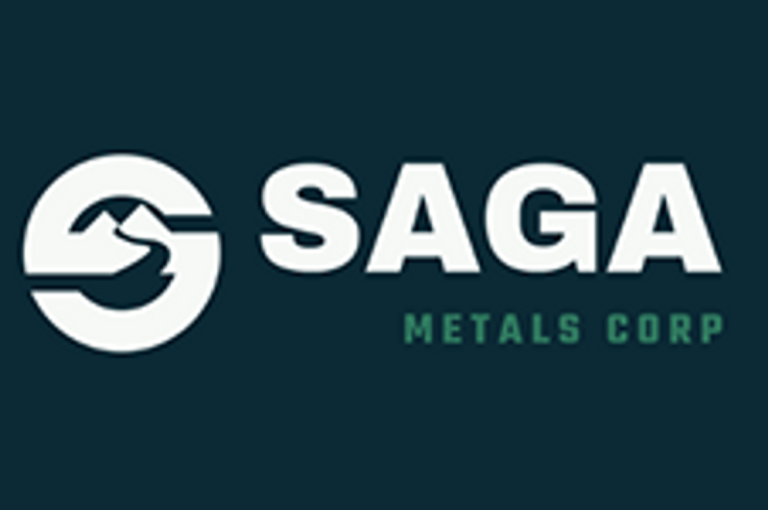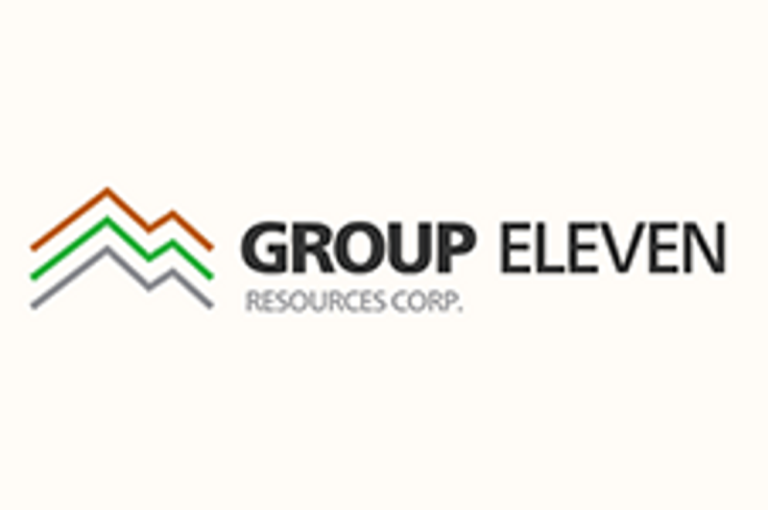Group Eleven Resources Corp. (TSXV: ZNG) (OTC Pink: GRLVF) (FSE: 3GE) (‘Group Eleven’ or the ‘Company’) is pleased to announce assay results from four new holes from the ongoing drill program at the Company’s 100%-owned Ballywire zinc-lead-silver discovery (‘Ballywire’), PG West Project (‘PG West’), Republic of Ireland.
Highlights:
- 25-3552-31, a 65m step-out hole, intersected two strongly mineralized horizons:
- Cu-Ag horizon (starting at 348.7m downhole)
- 19.9m of 1.46% Cu and 356 g/t Ag, including
- 12.0m of 2.30% Cu and 560 g/t Ag, including
- 6.4m of 3.72% Cu and 838 g/t Ag
- Zn-Pb-Ag horizon (starting at 297.0m downhole)
- 47.1m of 4.5% Zn+Pb (3.1% Zn and 1.4% Pb) and 22 g/t Ag, including
- 25.9m of 7.4% Zn+Pb (5.1% Zn and 2.3% Pb) and 35 g/t Ag, including
- 12.9m of 11.0% Zn+Pb (7.7% Zn and 3.2% Pb) and 57 g/t Ag, including
- 3.7m of 20.4% Zn+Pb (15.8% Zn and 4.6% Pb) and 151 g/t Ag
- Up to 10.45% Cu (over 0.80m) and up to 1,880 g/t Ag (over 0.86m) intersected in the Cu-Ag horizon; to the Company’s knowledge, this represents the highest-grade Ag intercept in Ireland over the last >60 years (by any operator) and similarly, one of the highest-grade Cu intercepts
- Cu-Ag horizon consists of replacement-style mineralization along the base of the Waulsortian Limestone in proximity to a fault structure; mineralization appears to consist mostly of tennantite-tetrahedrite (detailed mineralogy work to be undertaken in due course)
- Noteworthy is the presence of elevated antimony in the Cu-Ag zone, grading 0.27% Sb within the above 6.4m interval (including 0.80m of 10.45% Cu, 1215 g/t Ag and 0.83% Sb)
- This hole expands the footprint of the 2.6km long discovery trend by at least 65m down-dip, to a total of at least 170m down-dip along this section (and remains open further down-dip)
- Drilling continues at Ballywire with two rigs testing (i) the NE extension and (ii) 1.3km ENE of the Ballywire discovery in the vicinity of the prospective ‘D’ gravity-high anomaly; a third rig was added this week, testing the deeper Cu-Ag target (below the Waulsortian Limestone)
‘Intersecting spectacular copper-silver grades over significant thicknesses is a pivotal moment for the Ballywire discovery,’ stated Bart Jaworski, CEO. ‘These results not only strongly point to a stratigraphically deeper Cu-Ag horizon but also represent a proof of concept that substantial grades and thicknesses of copper and silver exist at the discovery, in addition to excellent grades of Zn-Pb. The growing presence of critical minerals at Ballywire, namely, copper, germanium and now potentially antimony, highlights the rising strategic importance of this discovery for Ireland, the EU and our shareholders. With today’s Cu-Ag milestone, continued drilling to the NE and along our prospective 6km trend, plus the start of drilling with our third rig, we are poised to further grow shareholder value as the year progresses.’
Exhibit 1. Cross-Section Showing New Drilling (25-3552-31) at Ballywire Discovery
To view an enhanced version of this graphic, please visit:
https://images.newsfilecorp.com/files/5685/251260_exhibit1.jpg
Note: True width of mineralized intervals in 25-3552-31, as a percent of down-hole interval, is estimated to be 50-70%
Exhibit 2. Plan Map Showing New Drilling and Intersected High-Grade Cu-Ag Mineralization
To view an enhanced version of this graphic, please visit:
https://images.newsfilecorp.com/files/5685/251260_exhibit2.jpg
New Step-Out Holes at Ballywire Discovery
The Ballywire prospect at the Company’s 100%-owned PG West Project in Republic of Ireland, represents the most significant mineral discovery in Ireland in over a decade. First announced in Sept-2022, the discovery has 52 holes drilled and reported by Group Eleven to date, including the most recent four holes (25-3552-30, -31, -32, and -33) reported today (see Exhibits 1 to 7).
High-grade Zn-Pb mineralization from 25-3552-31 (see Page 1 and Exhibits 1 to 4) consists predominantly of sphalerite, galena and pyrite. High-grade Cu-Ag mineralization in this hole consists of suspected tennantite/tetrahedrite, chalcopyrite, sphalerite, galena and pyrite along and/or close to the base of the Waulsortian Limestone (see Exhibit 1). Noteworthy is the presence of elevated antimony within the Cu-Ag zone. For example, the 6.39m interval below, grading 3.72% Cu and 838 g/t Ag, also grades 0.27% Sb (including 0.80m of 10.45% Cu, 1215 g/t Ag and 0.83% Sb).
Exhibit 3. Summary of Assays from 25-3552-31 at Ballywire
| Item |
From
(m) |
To
(m) |
Int
(m) |
Zn
(%) |
Pb
(%) |
Zn+Pb
(%) |
Ag
(g/t) |
Cu
(%) |
| 25-3552-31 |
155.00 |
155.84 |
0.84 |
8.41 |
1.70 |
10.11 |
93.8 |
– |
| And |
188.89 |
192.61 |
3.72 |
2.34 |
0.22 |
2.56 |
11.9 |
– |
| Incl. |
190.82 |
191.75 |
0.93 |
4.77 |
0.45 |
5.22 |
25.2 |
– |
| And |
296.95 |
344.07 |
47.12 |
3.13 |
1.37 |
4.50 |
21.6 |
– |
| Incl. |
300.76 |
301.70 |
0.94 |
5.21 |
0.72 |
5.93 |
13.9 |
– |
| And |
309.07 |
334.96 |
25.89 |
5.10 |
2.27 |
7.37 |
35.4 |
– |
| Incl. |
310.00 |
322.88 |
12.88 |
7.72 |
3.24 |
10.95 |
57.4 |
– |
| Incl. |
315.49 |
319.20 |
3.71 |
15.81 |
4.56 |
20.37 |
151.1 |
– |
| And |
347.79 |
370.42 |
22.63 |
0.47 |
0.51 |
0.98 |
315.8 |
1.30 |
| Incl. |
348.71 |
368.60 |
19.89 |
0.49 |
0.57 |
1.07 |
356.5 |
1.46 |
| Incl. |
348.71 |
360.73 |
12.02 |
0.59 |
0.79 |
1.38 |
560.1 |
2.30 |
| Incl. |
353.39 |
360.73 |
7.34 |
0.68 |
1.27 |
1.95 |
768.0 |
3.36 |
| Incl. |
354.34 |
360.73 |
6.39 |
0.65 |
1.46 |
2.11 |
838.0 |
3.72 |
| Incl. |
354.34 |
355.20 |
0.86 |
0.77 |
0.06 |
0.83 |
1880.0 |
5.73 |
| And |
355.20 |
356.09 |
0.89 |
0.09 |
0.02 |
0.11 |
516.0 |
1.12 |
| And |
356.09 |
357.02 |
0.93 |
0.40 |
8.47 |
8.87 |
399.0 |
1.16 |
| And |
357.02 |
357.98 |
0.96 |
0.36 |
1.15 |
1.51 |
128.0 |
1.19 |
| And |
357.98 |
358.78 |
0.80 |
2.44 |
0.21 |
2.65 |
1215.0 |
10.45 |
| And |
358.78 |
359.84 |
1.06 |
0.33 |
0.06 |
0.38 |
979.0 |
3.92 |
| And |
359.84 |
360.73 |
0.89 |
0.45 |
0.03 |
0.48 |
871.0 |
3.52 |
Note: True width of the mineralized interval in hole 25-3552-31, as a percentage of the down-hole interval, is estimated to be 50-70%; for photographs of Cu-Ag rich core, see Appendix and www.groupelevenresources.com.
Three other holes released today were drilled in a 150m gap to the NE of 25-3552-31 (25-3552-30, -32 and -33; see Exhibit 2). Hole 25-3552-30 returned nil mineralization, 25-3552-32 returned three intervals of mineralization up to 0.94m of 2.4% Zn+Pb (0.9% Zn and 1.5% Pb) and 8 g/t Ag, and 25-3552-33 returned three intervals of mineralization up to 0.82m of 2.9% Zn+Pb (1.1% Zn and 1.8% Pb) and 7 g/t Ag. These zones of mineralization are narrower and weaker than those at the main discovery trend but generally in line with recent holes drilled further to the ENE (see holes G11-3552-24, -26 and 28 in news release dated 25-Mar-2025). Disseminated copper mineralization, as well as, mineralized veins and fractures, is strengthening towards the north, suggesting massive sulphide mineralization may be present further north (see northern-most purple line in Exhibit 4). A second mineralized trend is also emerging to the south where the interpreted Cu-Ag rich ‘feeder’ fault pierced by drilling along the main discovery trend appears to correlate with mineralization approx. 350m along strike to the ENE, intersected in G11-3552-08 (see solid and dashed purple lines in Exhibit 4). Drilling is ongoing in the NE area to test the above targets.
Copper-Silver Target
Today’s results add to a growing body of evidence that support the interpretation of a Cu-Ag ‘feeder’ fault parallel to and spatially associated with the main Zn-Pb-Ag discovery at Ballywire (see Exhibit 4). With up to 10.45% Cu and 1,880 g/t Ag in a mineralized horizon near a steeply dipping structure, mineralizing fluids are interpreted to have emanated from deeper in the sedimentary sequence (see Exhibit 5). Meanwhile, the stratigraphy of the region suggests that the Lower Limestone Shale horizon exists approximately 100-200m below the discovery horizon (base of the Waulsortian Limestone). This horizon hosts four well known Cu-Ag historic occurrences in the surrounding area (see Denison, Oola, Gortdrum and Tullacondra in Exhibit 8, located approx. 5km, 9km, 10km and 45km away from Ballywire, respectively).
These historic Cu-Ag occurrences can be interpreted as the eroded remnants of originally more vertically extensive mineralizing systems, likely representing the roots of stratigraphically higher Zn-Pb-Ag mineralization. At Ballywire, the mineralizing system has the potential to be much larger than its neighbouring occurrences (based on a relatively larger footprint to date); additionally, any Cu-Ag mineralization would notionally be intact below the existing Zn-Pb-Ag mineralization.
Given the compelling nature of this exploration model, Group Eleven added a third rig and began drilling this deeper Cu-Ag target this week.
Exhibit 4. Plan Map Showing Interpreted Cu-Ag ‘Feeder’ at Ballywire
To view an enhanced version of this graphic, please visit:
https://images.newsfilecorp.com/files/5685/251260_exhibit4.jpg
Exhibit 5. Cross-Section Showing Hypothesized Cu-Ag Mineralization in the Lower Limestone Shale
To view an enhanced version of this graphic, please visit:
https://images.newsfilecorp.com/files/5685/251260_exhibit5.jpg
Exhibit 6. Oblique 3D View of Cu-Ag Mineralization at Ballywire
To view an enhanced version of this graphic, please visit:
https://images.newsfilecorp.com/files/5685/251260_exhibit6.jpg
Note: Bodies shown (calcite, Zn-Pb-Ag and Cu-Ag) are not constrained by any grade cut-off and are meant for illustrative purposes only
Exhibit 7. Regional Gravity at Ballywire Showing 6km Long Prospective Trend
To view an enhanced version of this graphic, please visit:
https://images.newsfilecorp.com/files/5685/251260_exhibit7.jpg
Notes to Exhibit 8: (a) Pallas Green MRE is owned by Glencore (see Glencore’s Resources and Reserves Report dated December 31, 2024); (b) Stonepark MRE: see the ‘NI 43-101 Independent Report on the Zinc-Lead Exploration Project at Stonepark, County Limerick, Ireland’, by Gordon, Kelly and van Lente, with an effective date of April 26, 2018, as found on SEDAR; and (c) the historic estimate at Denison was reported by Westland Exploration Limited in ‘Report on Prospecting Licence 464’ by Dermot Hughes dated May, 1988; the historic estimate at Gortdrum was reported in ‘The Geology and Genesis of the Gortdrum Cu-Ag-Hg Orebody’ by G.M. Steed dated 1986; and the historic estimate at Tullacondra was first reported by Munster Base Metals Ltd in ‘Report on Mallow Property’ by David Wilbur, dated December 1973; and later summarized in ‘Cu-Ag Mineralization at Tullacondra, Mallow, Co. Cork’ by Wilbur and Carter in 1986; the above three historic estimates have not been verified as current mineral resources; none of the key assumptions, parameters and methods used to prepare the historic estimates were reported and no resource categories were used; significant data compilation, re-drilling and data verification may be required by a Qualified Person before the historic estimates can be verified and upgraded to be compliant with current NI 43-101 standards; a Qualified Person has not done sufficient work to classify them as a current mineral resource and the Company is not treating the historic estimates as current mineral resources. ‘Rathdowney Trend’ is the south-westerly projection of the Rathdowney Trend, hosting the historic Lisheen and Galmoy mines.
Exhibit 8. Regional Map of Ballywire Discovery and Surrounding Cu-Ag Historic Occurrences
To view an enhanced version of this graphic, please visit:
https://images.newsfilecorp.com/files/5685/251260_exhibit8.jpg
Qualified Person
Technical information in this news release has been approved by Professor Garth Earls, Eur Geol, P.Geo, FSEG, geological consultant at IGS (International Geoscience Services) Limited, and independent ‘Qualified Person’ as defined under Canadian National Instrument 43-101.
Sampling and Analytical Procedures
All core drilled at Ballywire is NQ (47.6mm) and is cut using a rock saw. Sample intervals vary between 0.42m to 1.3m with the majority of samples in the 0.79m to 0.99m range. The half-core samples are bagged, labelled and sealed at Group Elevens core store facility in Limerick, Ireland. Selected sample bags are examined by the Qualified Person. Transport is via an accredited courier service and/or by Group Eleven staff to ALS Laboratories in Loughrea Co. Galway, Ireland. Sample preparation at the ALS facility comprises fine crushing 70%
Quality Assurance/Quality Control (QA/QC) Information
Group Eleven inserts certified reference materials (‘CRMs’ or ‘Standards’) as well as blank material, to its sample stream as part of its industry-standard QA/QC programme. The QC results have been reviewed by the Qualified Person, who is satisfied that all the results are within acceptable parameters. The Qualified Person has validated the sampling and chain of custody protocols used by Group Eleven.
About Group Eleven Resources
Group Eleven Resources Corp. (TSXV: ZNG) (OTC Pink: GRLVF) (FSE: 3GE) is drilling the most significant mineral discovery in the Republic of Ireland in over a decade. The Company announced the Ballywire discovery in September 2022, demonstrating high grades of zinc, lead, silver, copper, germanium and locally, antimony. Key intercepts to date include:
- 10.8m of 10.0% Zn+Pb and 109 g/t Ag (G11-468-03)
- 10.1m of 8.6% Zn+Pb and 46 g/t Ag (G11-468-06)
- 10.5m of 14.7% Zn+Pb, 399 g/t Ag and 0.31% Cu (G11-468-12)
- 11.2m of 8.9% Zn+Pb and 83 g/t Ag (G11-3552-03)
- 29.6m of 10.6% Zn+Pb, 78 g/t Ag and 0.15% Cu (G11-3552-12) and
- 11.8m of 11.6% Zn+Pb, 48 g/t Ag (G11-3552-18)
- 15.6m of 11.6% Zn+Pb, 122 g/t Ag and 0.19% Cu (G11-3552-27)
- 12.0m of 1.4% Zn+Pb, 560 g/t Ag, 2.30% Cu and 0.17% Sb (25-3552-31), including
- 6.4m of 2.1% Zn+Pb, 838 g/t Ag, 3.72% Cu and 0.27% Sb (25-3552-31)
Ballywire is located 20km from Company’s 77.64%-owned Stonepark zinc-lead deposit1, which itself is located adjacent to Glencore’s Pallas Green zinc-lead deposit2. The Company’s two largest shareholders are Glencore Canada Corp. (16.1% interest) and Michael Gentile (16.0%). Additional information about the Company is available at www.groupelevenresources.com.
ON BEHALF OF THE BOARD OF DIRECTORS
Bart Jaworski, P.Geo.
Chief Executive Officer
E: b.jaworski@groupelevenresources.com | T: +353-85-833-2463
E: j.webb@groupelevenresources.com | T: 604-644-9514
Neither TSX Venture Exchange nor its Regulation Services Provider (as that term is defined in the policies of the TSX Venture Exchange) accepts responsibility for the adequacy or accuracy of this release.
Cautionary Note Regarding Forward-Looking Information
This press release contains forward-looking statements within the meaning of applicable securities legislation. Such statements include, without limitation, statements regarding the future results of operations, performance and achievements of the Company, including the timing, content, cost and results of proposed work programs, the discovery and delineation of mineral deposits/resources/ reserves and geological interpretations. Although the Company believes that such statements are reasonable, it can give no assurance that such expectations will prove to be correct. Forward-Looking statements are typically identified by words such as: believe, expect, anticipate, intend, estimate, postulate and similar expressions, or are those, which, by their nature, refer to future events. The Company cautions investors that any forward-looking statements by the Company are not guarantees of future results or performance, and that actual results may differ materially from those in forward-looking statements as a result of various factors, including, but not limited to, variations in the nature, quality and quantity of any mineral deposits that may be located. All of the Company’s public disclosure filings may be accessed via www.sedarplus.ca and readers are urged to review these materials, including the technical reports filed with respect to the Company’s mineral properties.
APPENDIX – CORE PHOTOS
COPPER-SILVER ZONE IN HOLE 25-3551-31
(With Key Assay Results and Brief Descriptions of Key Mineralogy)
Core Boxes 103-105
To view an enhanced version of this graphic, please visit:
https://images.newsfilecorp.com/files/5685/251260_d0b183a384f7ba3f_009full.jpg
Core Boxes 106-108
To view an enhanced version of this graphic, please visit:
https://images.newsfilecorp.com/files/5685/251260_d0b183a384f7ba3f_010full.jpg
Core Boxes 109-111
To view an enhanced version of this graphic, please visit:
https://images.newsfilecorp.com/files/5685/251260_d0b183a384f7ba3f_011full.jpg
(1) Close-Up Core Photo
Above: Dolomitized Waulsortian Limestone, cross-cut by sulphide bearing veins (suspected tennatite-tetrahedrite, chalcopyrite and/or pyrite)
To view an enhanced version of this graphic, please visit:
https://images.newsfilecorp.com/files/5685/251260_d0b183a384f7ba3f_012full.jpg
(2) Close-Up Core Photo
Above: Suspected tennantite/tetrahedrite (grey), chalcopyrite and pyrite (yellow) and calcite (white)
To view an enhanced version of this graphic, please visit:
https://images.newsfilecorp.com/files/5685/251260_d0b183a384f7ba3f_013full.jpg
(3) Close-Up Core Photo
Above: Chalcopyrite with some pyrite (yellow) and suspected tennantite/tetrahedrite (grey), calcite (white)
To view an enhanced version of this graphic, please visit:
https://images.newsfilecorp.com/files/5685/251260_d0b183a384f7ba3f_014full.jpg
(4) Close-Up Core Photo
Above: Semi-massive chalcopyrite and pyrite (yellow), galena (reflective grey)
To view an enhanced version of this graphic, please visit:
https://images.newsfilecorp.com/files/5685/251260_d0b183a384f7ba3f_015full.jpg
(5) Close-Up Core Photo
Above: Waulsortian Limestones (grey), calcite (white), pyrite and chalcopyrite (yellow)
To view an enhanced version of this graphic, please visit:
https://images.newsfilecorp.com/files/5685/251260_d0b183a384f7ba3f_016full.jpg
(6) Close-Up Core Photo
Above: Suspected tennantite and tetrahedrite (dark grey), chalcopyrite (yellow), calcite (white)
To view an enhanced version of this graphic, please visit:
https://images.newsfilecorp.com/files/5685/251260_d0b183a384f7ba3f_017full.jpg
(6a) Close-Up Core Photo
Above: Suspected tennantite and tetrahedrite (dark grey), chalcopyrite (yellow), calcite (white)
To view an enhanced version of this graphic, please visit:
https://images.newsfilecorp.com/files/5685/251260_d0b183a384f7ba3f_018full.jpg
(7) Close-Up Core Photo
Above: Suspect tennantite and tetrahedrite (dark grey), chalcopyrite (yellow), calcite (white)
To view an enhanced version of this graphic, please visit:
https://images.newsfilecorp.com/files/5685/251260_d0b183a384f7ba3f_019full.jpg
(8) Close-Up Core Photo
Above: Chalcopyrite (yellow), suspected tennantite/tetrahedrite (grey), calcite (white)
To view an enhanced version of this graphic, please visit:
https://images.newsfilecorp.com/files/5685/251260_d0b183a384f7ba3f_020full.jpg
(9) Close-Up Core Photo
Above: Fault zone (juxtaposing sub-Waulsortian lithologies against Waulsortian Limestone)
To view an enhanced version of this graphic, please visit:
https://images.newsfilecorp.com/files/5685/251260_d0b183a384f7ba3f_021full.jpg
1 Stonepark MRE is 5.1 million tonnes of 11.3% Zn+Pb (8.7% Zn and 2.6% Pb), Inferred (Apr-17-2018)
2 Pallas Green MRE is 45.4 million tonnes of 8.4% Zn+Pb (7.2% Zn + 1.2% Pb), Inferred (Glencore, Dec-31-2024)
To view the source version of this press release, please visit https://www.newsfilecorp.com/release/251260










